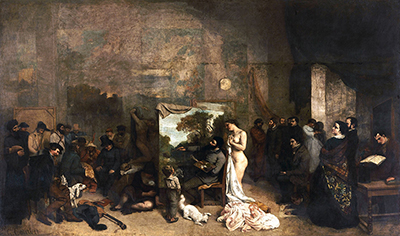This famous Gustave Courbet painting from 1855 can be considered one of his boldest and most respected of all, impressing both in its size but also the careful use of representational art that can be found spread right across this huge canvas.
This intriguing artwork summarises all of the major artistic influences on Courbet up to the point at which he produced this painting, 1855. He represents a large number of individuals and summarises the content with its extended title of 'A real allegory summing up seven years of my artistic and moral life'. There is a symbolic representation of his decision to turn away from traditional art, towards the realism movement that he would later head. This is achieved in the scene by his rejection of a nude model who is used to represent artistic genres of the past. This bold approach was typically derided by some parts of the Paris art community, but Romanticist painter, Eugene Delacroix, notably stood up in support of The Painter's Studio and praised many of its clear qualities.
The huge painting measures 361 cm × 598 cm (142 in × 235 in) and would be too big for most galleries to display suitably. It can now be found at the Musée d'Orsay, Paris which is a fitting location for this beautiful painting, with it sitting alongside work by many other great names from past centuries. L'Atelier du peintre. Allégorie réelle déterminant une phase de sept années de ma vie artistique et morale, to give it its original, elongated French title, can be considered one of the most impressive parts of the insitution's considerable collection. Within Paris, it is only surpassed by the world-famous Louvre Gallery. You can discover the likes of Frédéric Bazille, William-Adolphe Bouguereau, Gustave Caillebotte, Paul Cézanne, Edgar Degas and Jean-Léon Gérôme. Their collection of Courbet's work alone is considerable, boasting around 48 paintings to date including The Artist's Studio, A Burial at Ornans, Young Man Sitting, L'Origine du monde and The Wounded Man amongst the highlights.
The Painter's Studio was completed by artist Courbet in Ornans, a location that he loved and prefered to his time living in the French capital, Paris. To section up the composition, we find the left dominated with a wide selection of individuals related to his lifetime. Centrally, the artist himself visually turns his back on traditional art in pursuit of this new school of Realism. To the right we find predominantly eminent figures from Parisian life, all of which played a role in his rise to fame. Some of those have been identified as Charles Baudelaire, Champfleury, Pierre-Joseph Proudhon and Alfred Bruyas. The latter, of course, famously appears in The Meeting.




